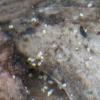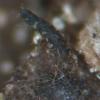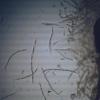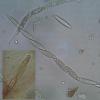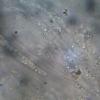
16-07-2011 18:29
Tourbière, haute Ardenne. Par acquis de conscienc

07-01-2012 12:42
Bonjour à tous,L'un de vous aurait-il l'article s

25-11-2011 04:40
Ridha EL MOKNIGood morning every body, I am looking for some li

31-12-2011 17:30
 Martin Bemmann
Martin Bemmann
Hi all,does somebody have a copy of the paper by G

01-01-2012 20:41
 Björn Wergen
Björn Wergen
Hi again,there are a few hypoxylon-like specimen I

31-12-2011 19:35
 Björn Wergen
Björn Wergen
Hi,I have some problems with this pyrenomycete, wh

20-12-2011 11:27
Gernot FriebesHi,T. Richter found an interesting pyrenomycete gr
Pyreno s/ graminée ou carex mort
Luc Bailly,
16-07-2011 18:29
Périthèces noires, hirsutes par la présence d'une gaine d'hyphe brunes; pas de stroma; taille -> 1 mm. Col ~0.8 mm x 0.1-0.2 mm, noir, à l'apex plus clair.
Asques 8-sp., sp. unisériées, IKI - ; taille p.ex. 240 x 11 µ pour un appareil apical réfringent 4 x 5 µ.
Sp. hyalines, fusiformes, le plus souvent 7-septées, guttulées (huile=4-5), (27)31-39(42) x 7-8.2(9) µ.
Paraphyses hyalines, guttulées, x 1.5-2 µ
Hyphes hirsutes brunes ramifiées, lisses, septées, x 2-3 µ.
Une idée?
Merci d'avance, amitiés - LUC.
Hans-Otto Baral,
16-07-2011 18:58

Re : Pyreno s/ graminée ou carex mort
Interesting that such Annulatascaceae occur also on grasses, I know them only lignicolous. Possibly a member of Annulusmagnus.
Zotto
Zotto
Luc Bailly,
16-07-2011 21:51
Re : Pyreno s/ graminée ou carex mort
Hi Zotto,
Thank you for the suggestion. I agree with you it's an Annulastacaceae, with the uniseriate asci, the large apical ring and the septate spores. But I'm still clueless when I search further in the refs I have here :/
Je n'ai utilisé qu'une seule fructification. Si quelqu'un veut l'étudier (si cela s'avère être quelque chose de vraiment intéressant), je peux le lui envoyer par la poste. L'exemplaire est dans une boîte fermée, au frigo.
Amitiés - Luc BAILLY.
EDIT: Ci-dessous, une photo générale du substrat. C'est ce petit "machin".
Thank you for the suggestion. I agree with you it's an Annulastacaceae, with the uniseriate asci, the large apical ring and the septate spores. But I'm still clueless when I search further in the refs I have here :/
Je n'ai utilisé qu'une seule fructification. Si quelqu'un veut l'étudier (si cela s'avère être quelque chose de vraiment intéressant), je peux le lui envoyer par la poste. L'exemplaire est dans une boîte fermée, au frigo.
Amitiés - Luc BAILLY.
EDIT: Ci-dessous, une photo générale du substrat. C'est ce petit "machin".
Luc Bailly,
03-01-2012 21:15
Re : Pyreno s/ graminée ou carex mort
Oh, je tombe sur un document montrant des périthèces hirsutes comme ça: cela ne pourrait pas être un Gaeumannomyces? Il y en a qui poussent sur Poaceae.
Y a-t-il une clé des espèces de ce genre?
Y a-t-il une clé des espèces de ce genre?
Alain GARDIENNET,
07-01-2012 08:12
Re : Pyreno s/ graminée ou carex mort
Bonjour Luc,
Un Gaeumannomyces? Je ne pense pas, les spores ont filliformes en général à ma connaissance. La piste des Annulatascaceae est à considérer sérieusement. Il y a de nombreux genres, et ce n'est probablement pas un Annulusmagnus mais un autre genre.
Si ça peut t'aider à avancer...
Alain
Un Gaeumannomyces? Je ne pense pas, les spores ont filliformes en général à ma connaissance. La piste des Annulatascaceae est à considérer sérieusement. Il y a de nombreux genres, et ce n'est probablement pas un Annulusmagnus mais un autre genre.
Si ça peut t'aider à avancer...
Alain
Luc Bailly,
07-01-2012 12:38
Re : Pyreno s/ graminée ou carex mort
Bonjour Alain et merci.
Après avoir regardé quelques documents concernant les Annulastacaceae, je pense de plus en plus que c'en est une.
Je vais lancer un appel pour un peu de biblio.
Amitiés - LUC.
Après avoir regardé quelques documents concernant les Annulastacaceae, je pense de plus en plus que c'en est une.
Je vais lancer un appel pour un peu de biblio.
Amitiés - LUC.
Luc Bailly,
07-01-2012 18:42
Re : Pyreno s/ graminée ou carex mort
Les Annulatascaceae ne donnent rien, ils sont tous lignicoles.
Les Gaeumannomyces font partie de la famille des Magnaporthaceae, sans doute faudrait-il regarder dans cette direction.
Amitiés - LUC.
Les Gaeumannomyces font partie de la famille des Magnaporthaceae, sans doute faudrait-il regarder dans cette direction.
Amitiés - LUC.
Alain GARDIENNET,
07-01-2012 20:33
Re : Pyreno s/ graminée ou carex mort
Les Annulastacaeae ne sont pas tous lignicoles, de nos jours. De mémoire, je pense à Saccardoëlla miscanthi par exemple. Peut-être ne faut-il pas les éliminer trop vite.
Peut-être aussi que ton pyréno est une espèce inédite.
Alain
Peut-être aussi que ton pyréno est une espèce inédite.
Alain
Luc Bailly,
08-01-2012 00:33
Re : Pyreno s/ graminée ou carex mort
Bonjour Alain,
Il y a du neuf: Martin Bemmann vient de m'envoyer la description d'Annulastacus nilensis, qui pousse sur Phragmites: les spores sont presque identiques (juste dans la moitié inférieure de la fourchette donnée pour A. nilensis). La forme de la périthèce est similaire (avec un col plus long chez ma récolte des fagnes), mais je n'ai pas observé de base allongée aux asques.
On a donc très probablement un nom de genre: Annulastacus. C'est déjà ça. Le tout est maintenant d'obtenir la description d'autres espèces graminicoles du genre Annulastacus, ou une clé de détermination.
Amitiés - Luc BAILLY.
Il y a du neuf: Martin Bemmann vient de m'envoyer la description d'Annulastacus nilensis, qui pousse sur Phragmites: les spores sont presque identiques (juste dans la moitié inférieure de la fourchette donnée pour A. nilensis). La forme de la périthèce est similaire (avec un col plus long chez ma récolte des fagnes), mais je n'ai pas observé de base allongée aux asques.
On a donc très probablement un nom de genre: Annulastacus. C'est déjà ça. Le tout est maintenant d'obtenir la description d'autres espèces graminicoles du genre Annulastacus, ou une clé de détermination.
Amitiés - Luc BAILLY.
Alain GARDIENNET,
08-01-2012 10:16
Re : Pyreno s/ graminée ou carex mort
Espèce assez proche en effet, mais étant donné qu'il y a des différences que tu as notées il faudrait pousser plus loin l'investigation. Exemple : est-ce que tes spores possèdent une gangue granuleuse comme le montre bien une photo de nilensis ? Ca vaudrait le coup de vérifier, ça me semble être un critère important. La longueur des pédicelles de tes asques est différente aussi, peut-être faudrait-il refaire un examen ou deux. Tu pourrais en profiter pour voir si la paroi est identique à celle de nilensis.
Ensuite tu parles de paraphyses, au sens large je suppose. As-tu observé comment était ton hamathécium ? Est-ce que ce sont des paraphyses (s.s.) ou des périphyses ? Ca serait bien de voir d'où part leur formation.
Ce qui me gênait était l'habitat : nilensis est bien immergé dans les tissus du roseau.
Probablement très proche de nilensis. Si tu ne peux aller plus loin conserve bien cette récolte (en sp. cf nilensis), elle pourrait servir plus tard à d'autres.
De mon côté, je vais essayer de regarder les graminées immergées attentivement. Ce serait bien de retrouver des récoltes comparables.
Ensuite tu parles de paraphyses, au sens large je suppose. As-tu observé comment était ton hamathécium ? Est-ce que ce sont des paraphyses (s.s.) ou des périphyses ? Ca serait bien de voir d'où part leur formation.
Ce qui me gênait était l'habitat : nilensis est bien immergé dans les tissus du roseau.
Probablement très proche de nilensis. Si tu ne peux aller plus loin conserve bien cette récolte (en sp. cf nilensis), elle pourrait servir plus tard à d'autres.
De mon côté, je vais essayer de regarder les graminées immergées attentivement. Ce serait bien de retrouver des récoltes comparables.
Luc Bailly,
08-01-2012 15:38
Re : Pyreno s/ graminée ou carex mort
Bonjour Alain,
Malheureusement, je ne pense pas avoir gardé le spécimen: trop peu d'exemplaires, et je pensais que je n'en ferais jamais rien. Et j'avais encore d'autres récoltes à observer.
Heureusement, je me souviens où je l'ai trouvé, et ce sont des milieux que je connais bien: j'irai fouiner à nouveau dans mes places en saison. Dès qu'il y a du neuf, j'en reparlerai.
Les spores étaient complètement lisses, du moins dans l'eau. Il faudrait voir ce que cela donnerait dans l'encre.
Même chose pour les paraphyses: il faudra que j'essaie avec des colorations si je retrouve l'espèce.
Et il y a plusieurs Annulatascus qui n'ont pas la base de l'asque allongée.
Enfin, le jour où je tombe à nouveau là-dessus, je saurai dans quelle direction fouiner, et quels sont les caractères à observer.
Amitiés - LUC.
Malheureusement, je ne pense pas avoir gardé le spécimen: trop peu d'exemplaires, et je pensais que je n'en ferais jamais rien. Et j'avais encore d'autres récoltes à observer.
Heureusement, je me souviens où je l'ai trouvé, et ce sont des milieux que je connais bien: j'irai fouiner à nouveau dans mes places en saison. Dès qu'il y a du neuf, j'en reparlerai.
Les spores étaient complètement lisses, du moins dans l'eau. Il faudrait voir ce que cela donnerait dans l'encre.
Même chose pour les paraphyses: il faudra que j'essaie avec des colorations si je retrouve l'espèce.
Et il y a plusieurs Annulatascus qui n'ont pas la base de l'asque allongée.
Enfin, le jour où je tombe à nouveau là-dessus, je saurai dans quelle direction fouiner, et quels sont les caractères à observer.
Amitiés - LUC.

